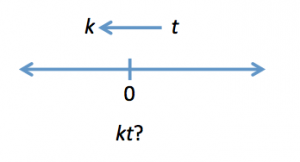-
Target Test Prep 20% Off Flash Sale is on! Code: FLASH20
Redeem
GMAT Data Sufficiency Strategy: Test Cases
 If youre going to do a great job on Data Sufficiency, then youve got to know how to Test Cases. This strategy will help you on countless DS problems.
If youre going to do a great job on Data Sufficiency, then youve got to know how to Test Cases. This strategy will help you on countless DS problems.
Try this GMATPrep problem from the free exams. Give yourself about 2 minutes. Go!
* On the number line, if the number k is to the left of the number t, is the product kt to the right of t?(1) t < 0
(2) k < 1
If visualizing things helps you wrap your brain around the math (it certainly helps me), sketch out a number line:
k is somewhere to the left of t, but the two actual values could be anything. Both could be positive or both negative, or k could be negative and t positive. One of the two could even be zero.
The question asks whether kt is to the right of t. That is, is the product kt greater than t by itself?
There are a million possibilities for the values of k and t, so this question is what we call a theory question: are there certain characteristics of various numbers that would produce a consistent answer? Common characteristics tested on theory problems include positive, negative, zero, simple fractions, odds, evens, primesbasically, number properties.
(1) t < 0"
This problem appears to be testing positive and negative, since the statement specifies that one of the values must be negative. Test some real numbers, always making sure that t is negative.
Case #1:
Testing Cases involves three consistent steps:
First, choose numbers to test in the problem
Second, make sure that you have selected a valid case. All of the givens must be true using your selected numbers.
Third, answer the question.
In this case, the answer is Yes. Now, your next strategy comes into play: try to prove the statement insufficient.
How? Ask yourself what numbers you could try that would give you the opposite answer. The first time, you got a Yes. Can you get a No
Case #2:
Careful: this is where you might make a mistake. In trying to find the opposite case, you might try a mix of numbers that is invalid. Always make sure that you have a valid case before you actually try to answer the question. Discard case 2.
Case #3:
Hmm. We got another Yes answer. What does this mean? If you cant come up with the opposite answer, see if you can understand why. According to this statement, t is always negative. Since k must be smaller than t, k will also always be negative.
The product kt, then, will be the product of two negative numbers, which is always positive. As a result, kt must always be larger than t, since kt is positive and t is negative.
Okay, statement (1) is sufficient. Cross off answers BCE and check out statement (2):
(2) k < 1
You know the drill. Test cases again!
Case #1:
Youve got a No answer. Try to find a Yes.
Case #2:
Hmm. I got another No. What needs to happen to make kt > t? Remember what happened when you were testing statement (1): try making them both negative!
In fact, when youre testing statement (2), see whether any of the cases you already tested for statement (1) are still valid for statement (2). If so, you can save yourself some work. Ideally, the below would be your path for statement (2), not what I first showed above:
(2) k < 1
Case #1:
All you have to do is make sure that the case is valid. If so, youve already done the math, so you know that the answer is the same (in this case, Yes).
Now, try to find your opposite answer: can you get a No?
Case #2: Try something I couldnt try before. k could be positive or even 0
A Yes and a No add up to an insufficient answer. Eliminate answer (D).
The correct answer is (A).
Guess what? The technique can also work on some Problem Solving problems. Try it out on the following GMATPrep problem, then join me next week to discuss the answer:
* For which of the following functions f is f(x) = f(1 x) for all x?(A) f(x) = 1 x
(B) f(x) = 1 [pmath]x^2[/pmath]
(C) f(x) = [pmath]x^2-(1-x)^2[/pmath]
(D) f(x) = [pmath]x^2(1-x)^2[/pmath]
(E) [pmath]f(x)=x/{1-x}[/pmath]
Key Takeaways: Test Cases on Data Sufficiency
(1) When DS asks you a theory question, test cases. Theory questions allow multiple possible scenarios, or cases. Your goal is to see whether the given information provides a consistent answer.
(2) Specifically, try to disprove the statement: if you can find one Yes and one No answer, then youre done with that statement. You know its insufficient. If you keep trying different kinds of numbers but getting the same answer, see whether you can think through the theory to prove to yourself that the statement really does always work. (If you cant, but the numbers you try keep giving you one consistent answer, just go ahead and assume that the statement is sufficient. If youve made a mistake, you can learn from it later.)
* GMATPrep questions courtesy of the Graduate Management Admissions Council. Usage of this question does not imply endorsement by GMAC.
Recent Articles
Archive
- April 2024
- March 2024
- February 2024
- January 2024
- December 2023
- November 2023
- October 2023
- September 2023
- July 2023
- June 2023
- May 2023
- April 2023
- March 2023
- February 2023
- January 2023
- December 2022
- November 2022
- October 2022
- September 2022
- August 2022
- July 2022
- June 2022
- May 2022
- April 2022
- March 2022
- February 2022
- January 2022
- December 2021
- November 2021
- October 2021
- September 2021
- August 2021
- July 2021
- June 2021
- May 2021
- April 2021
- March 2021
- February 2021
- January 2021
- December 2020
- November 2020
- October 2020
- September 2020
- August 2020
- July 2020
- June 2020
- May 2020
- April 2020
- March 2020
- February 2020
- January 2020
- December 2019
- November 2019
- October 2019
- September 2019
- August 2019
- July 2019
- June 2019
- May 2019
- April 2019
- March 2019
- February 2019
- January 2019
- December 2018
- November 2018
- October 2018
- September 2018
- August 2018
- July 2018
- June 2018
- May 2018
- April 2018
- March 2018
- February 2018
- January 2018
- December 2017
- November 2017
- October 2017
- September 2017
- August 2017
- July 2017
- June 2017
- May 2017
- April 2017
- March 2017
- February 2017
- January 2017
- December 2016
- November 2016
- October 2016
- September 2016
- August 2016
- July 2016
- June 2016
- May 2016
- April 2016
- March 2016
- February 2016
- January 2016
- December 2015
- November 2015
- October 2015
- September 2015
- August 2015
- July 2015
- June 2015
- May 2015
- April 2015
- March 2015
- February 2015
- January 2015
- December 2014
- November 2014
- October 2014
- September 2014
- August 2014
- July 2014
- June 2014
- May 2014
- April 2014
- March 2014
- February 2014
- January 2014
- December 2013
- November 2013
- October 2013
- September 2013
- August 2013
- July 2013
- June 2013
- May 2013
- April 2013
- March 2013
- February 2013
- January 2013
- December 2012
- November 2012
- October 2012
- September 2012
- August 2012
- July 2012
- June 2012
- May 2012
- April 2012
- March 2012
- February 2012
- January 2012
- December 2011
- November 2011
- October 2011
- September 2011
- August 2011
- July 2011
- June 2011
- May 2011
- April 2011
- March 2011
- February 2011
- January 2011
- December 2010
- November 2010
- October 2010
- September 2010
- August 2010
- July 2010
- June 2010
- May 2010
- April 2010
- March 2010
- February 2010
- January 2010
- December 2009
- November 2009
- October 2009
- September 2009
- August 2009







